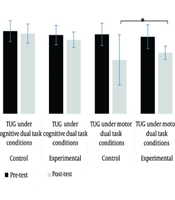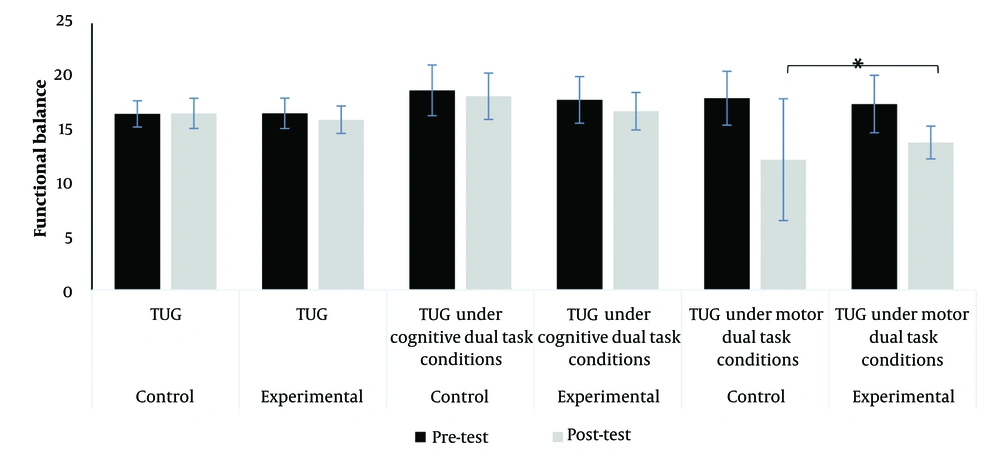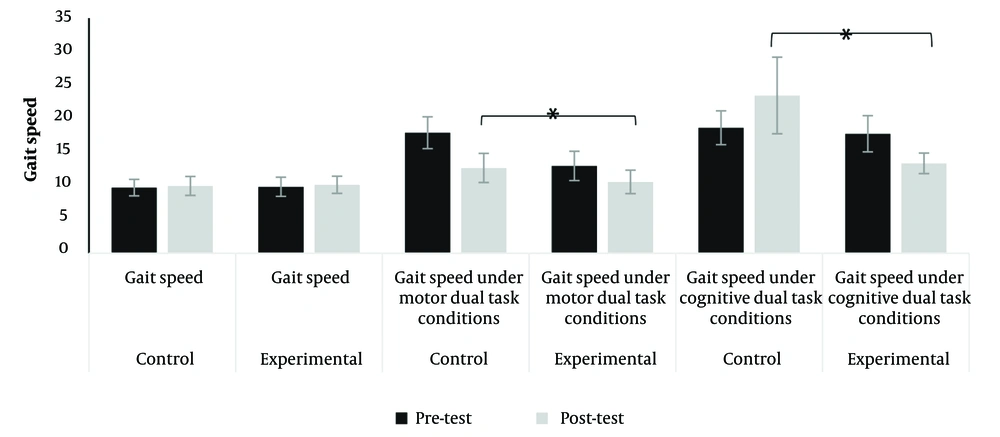1. Background
Bipolar disorder, a mood disorder affecting approximately 400 million people worldwide, is characterized by recurring cycles of depression and manic or hypomanic episodes (1). According to the World Health Organization’s report in 2022, nearly one billion people globally will experience some form of mental disorder. Shockingly, approximately 6% of these individuals grapple with bipolar disorder (2). Research increasingly points to a connection between mood disorders and motor behavior irregularities. One of the pioneering investigations was conducted by Lemke et al. (3) that focused on spatial and temporal parameters of walking in patients with depressive disorder. The findings revealed that depressed patients exhibited significant reductions in gait velocity, reduced stride length, double limb support and cycle duration. Notably, individuals with bipolar disorder exhibit an unsteady walking pattern. In a study by Kang et al. 2019, researchers explored gait patterns across various stages of bipolar disorder—hypomanic, euthymic, and depressed. Notably, they observed significant differences in walking speed, maximum power, and maximum force specifically among hypomanic participants. Kang et al. (4) reported that bipolar patients in the depressive phase, despite being relatively young adults (age less than 45 years), have balance disturbances during movements. Research reveals that performing cognitive tasks while walking significantly influences gait characteristics. Springer et al. (5) discovered that swing time variability in older adults increased during the performing of secondary cognitive tasks. This effect is particularly pronounced among older adults and individuals with neurological conditions (6).
It has been proposed that dual-task training may be more effective for improving dual-task performance than single-task training (7). According to Kramer et al.'s 1995 theory, dual-task practice improves new dual-task practice because improved dual-task processing skills transfer to other unpracticed dual-task domains (8). Azadian et al. (9) and Konak et al., (10) showed the effectiveness of dual-task training on balance and gait speed. Bipolar disorder significantly impacts both motor and cognitive dimensions, affecting an individual’s independence. To address these challenges, targeted interventions are essential. By simultaneously engaging both cognitive and motor dimensions, this approach provides valuable insights into real-world scenarios (11). Jardim et al. (12) emphasized the importance of incorporating multi-faceted physical exercises—such as a combination of aerobic exercise and strength training—in dual-task models.
2. Objectives
Considering the scarcity of studies on bipolar patients, this research aims to investigate the effects of dual-task training on the functional balance and gait speed under dual-task conditions of individuals with bipolar disorder.
3. Methods
3.1. Subjects
Based on entry and exit criteria, 30 patients were selected as the study sample. The criteria for participation in the study include the following, a definite diagnosis of bipolar disorder by a psychiatrist. Receiving at least one antipsychotic drug and daily use of at least one benzodiazepine for a minimum of 3 months (4). Participants were excluded for any of the following reasons, rapid cycling bipolar disorder, defined as having more than four episodes of depression and mania lasting less than one month within the past year (4)). The samples were divided into two groups: The dual-task training group and the control group.
3.2. Apparatus and Task
3.2.1. Timed Up & Go Test
Balance ability was measured using the timed up and go test (TUG) (13). In a motor dual-task TUG test, the patients were required to complete the TUG task while gripping a cup of water that was filled to a height of 3 cm. In a cognitive dual-task TUG test, the patients had to finish the TUG while counting down from a randomly chosen number between 70 and 99 by threes (14).
3.2.2. The 10-Meter Walk Test
Three situations were used to assess gait speed: Simple, cognitive dual-task, and motor dual-task. The patients engaged in a one-back secondary spatial visual task and then performed a 10-meter walk test. The patients were asked to walk 10 meters with a cup of water in their dominant hand during the test (15).
3.3. Procedure
3.3.1. Physical Exercise in a Dual-Task Intervention Program
The dual-task practice was taken from Jardim et al.'s study (12). There were twenty sessions in the intervention program. Warm-up (10 minutes), aerobic (30 minutes), resistance (30 minutes), and stretching (5 minutes) at 60% - 70% heart rate maximum (HR max) were the first activities of each session (Appendix 1). During the exercises, we monitored heart rate using the Beurer PM 15 heart rate monitor, manufactured by Beurer in Germany.
3.3.2. Cognitive Stimulation
The cognitive stimulation protocol associated with physical exercise included a multisensory stimuli protocol based on a previous study (16).
After obtaining consent, the researchers measured demographic characteristics, walking speed, and functional balance. For ten weeks, patients in the intervention group engaged in pertinent programs, control group carried on usual routine. Finally, all measurements were repeated after 10 weeks.
3.4. Data Analysis
All statistical analyzes were performed with SPSS® 26.0. Analysis of covariance test (ANCOVA) was used to analyze the data.
4. Results
Table 1 displays the demographic data for each group.
| Group | Age (y) | Weight (kg) | Height (m) |
|---|---|---|---|
| Control | 43.27 ± 8.92 | 70.87 ± 5.11 | 169.20 ± 2.81 |
| Dual-task training | 43.40 ± 8.09 | 70.60 ± 3.06 | 172.40 ± 5.23 |
Mean ± Standard Deviation of the Demographic Characteristics of the Studied Groups
The ANCOVA test results showed there was no statistically significant diffrerence at the post-test between the experimental and control groups concerning the TUG [F (1,27) = 0.73, P = 0.40] and TUG under cognitive dual-task conditions [F (1,27) = 0.73, P = 0.39]. A significant difference was found in the TUG under motor dual-task conditions between groups [F (1,27) = 17.40, P = 0.001, μ2= 0.39]. The adjusted group means revealed that the experimental group’s mean score for the TUG under motor dual-task conditions (estimated mean = 13.97) was significantly lower than that of the control group (estimated mean = 17.03) (Figure 1).
However, the assessment of gait speed did not yield any significant differences at the post-test between the groups [F (1,27) = 0.12, P = 0.72]. In the assessment of gait speed under motor dual-task conditions, a significant difference emerged between groups [F (1,27) = 25.03, P < 0.001, μ2= 0.48]. Examination of the adjusted mean scores indicated that the experimental group’s average gait speed under motor dual-task conditions (estimated mean = 10.58) was lower than to that of the control group (estimated mean = 12.76).
Furthermore, when analyzing gait speed under cognitive dual-task conditions, a substantial difference was noted between the experimental and control groups (F = 97.32, P < 0.001, μ2 = 0.78). The adjusted mean comparisons revealed that the experimental group’s average gait speed under cognitive dual-task conditions (estimated mean = 13.58) was significantly lower compared to the control group (estimated mean = 23.29) (Figure 2).
The assessment of gait speed did not yield any significant differences at the post-test between the groups [F (1,27) = 0.12, P = 0.72]. However, a significant difference emerged in the assessment of gait speed under motor dual-task conditions [F (1,27) = 25.03, P < 0.001, η² = 0.48]. Examination of the adjusted mean scores indicated that the experimental group’s average gait speed under motor dual-task conditions (estimated mean = 10.58) was lower than that of the control group (estimated mean = 12.76).
Furthermore, a substantial difference was noted in gait speed under cognitive dual-task conditions between the experimental and control groups (F = 97.32, P < 0.001, η² = 0.78). The adjusted mean comparisons revealed that the experimental group’s average gait speed under cognitive dual-task conditions (estimated mean = 13.58) was significantly lower compared to the control group (estimated mean = 23.29) (Figure 2).
5. Discussion
This study was conducted with the aim of investigating the effect of dual-task training on functional balance and gait speed under dual-task conditions. The results of this study showed that dual-task training significantly improved TUG under motor dual-task conditions, gait speed under motor dual-task conditions and Gait speed under cognitive dual-task conditions.
The current study confirmed an improvement in gait speed under motor dual-task conditions, corroborating the findings of Liu et al. (17) and Plummer et al. (18), who demonstrated that dual-task walking training improved walking speed under motor dual-task conditions. Walking and cognitive functions are interconnected through shared neural circuits. It has been demonstrated that dual-task exercises of varying intensities enhance both cognitive abilities and walking pace (19, 20). walking requires a healthy nervous system, attention and planning. Cognitive impairment affects planning and multisensory integration process for walking. Participating in cognitive activities is effective for improving neuromotor function (21).
Previous studies showed cognitive impairment in bipolar patients. Dual-task training, increases the activation of Broca's area, the corresponding area in the right hemisphere, extensive activation of the cerebral cortex throughout the fronto-temporal-parietal regions and the prefrontal cortex. Muscular weakness of the lower limb is an element that limits the patient's functional recovery and can lead to deficits in maintaining balance and walking ability (22). Therefore, it is possible that dual-task physical training, which is a combination of aerobic training and strength training, has strengthened the iliopsoas muscle and lower limb extensors and improved walking stability in these patients. Dual-task paradigms are commonly used to investigate the extent to which cognitive resources are allocated between two tasks (23). If two tasks performed simultaneously require more attention than the total capacity, the quality of performance on one or both tasks is reduced. It is possible that when performing the dual cognitive task exercise, the cognitive load at the same time caused a disturbance during the execution of the exercises during the intervention. As a result, to compensate for this disturbance, the patients engaged the muscles more and the muscle strength and neuromuscular preparation improved, and this caused Improvement of gait speed under motor dual-task conditions in the dual-task group. Also, participating in the dual-task exercise has helped the participant to learn the strategy of allocating attention to two simultaneous tasks.
Another finding was the improvement in gait speed under cognitive dual-task conditions. This can be attributed to the capacity-sharing theory, which suggests that in a scenario of limited attentional resources, multitasking may compromise at least one task’s performance (24). A cognitive dual-task training intervention that includes muscle strengthening, balance, and walking exercises could potentially increase motor capacity. This, in turn, may decrease the cognitive load of motor tasks, thereby freeing up attentional resources for additional tasks.
The study found no significant difference in gait speed between control and experimental groups. Contrarily, Fritz et al. (25) observed enhanced spatiotemporal aspects of single-task walking in Parkinson’s and Alzheimer’s patients following dual-task training. He et al. (26) reported enhanced walking performance in stroke patients following dual-task training. Azadian et al. (9) studied the impact of dual-task training on the gait of elderly individuals with balance disorders, finding improvements in walking speed and stride length. However, these findings diverge from those reported by Fritz et al. (25), He et al. (26), and Azadian et al. (9). A potential explanation for the inconsistency in findings is the variable walking speed of bipolar patients due to their mood phase. During mania, increased energy and step length may lead to faster walking speeds, while the opposite occurs during depression, with reduced step length slowing them down (27). This variation could account for the observed lack of difference in walking speeds, depending on the patients’ current mood phase.
Dual-task training did not improve TUG performance. Contrary to Konak et al. (10) who observed significant improvements in functional balance with both single and dual-task balance training programs in elderly individuals with osteoporosis over a 4-week period. our findings were not in alignment. The inconsistency observed may be attributed to variations in physical exercise regimens, intervention duration, or participant characteristics. In Konak et al.'s 2016 study (10), physical exercise in the dual-task intervention was balance exercise. But in this study, physical training included strength and aerobic training, and balance training may have been more effective for improving functional balance. Also, in the present study, the dual-task practice was 2 times a week, but in their study it was 3 times a week, and it is possible that the effectiveness of doing 3 times a week was more than 2 times a week. Chen et al. (28) stated that TUG is more affected by general mental function and these interventions may not have contributed much to improve general mental function.
Another finding of the current research showed that the TUG under cognitive dual-task conditionsdid not improve. Chen et al. (28) stated that TUG under cognitive dual-task conditions is more affected by attention. Since the practice of dual-task plays a role in improving attention, but in the present study, TUG under cognitive dual-task conditions was not improved. Bipolar patients usually have cognitive and attention problems. Also, depressed patients have more problems in performing dual-tasks. It is possible that the exercise program of this study was not possible to improve the attention of these patients. Of course, due to the fact that we did not measure the attention of the patients, we cannot justify the reason for the lack of improvement with certainty. Action orientation interference theory can be used to explain this finding. According to this theory, selective interference during movement depends on the nature of the action (29). In this way, a cognitive task such as counting backwards can have a negative effect on the execution of the movement task of TUG. According to the theory of limited attention capacity (30), a person spends most of his attention on the dual cognitive task (counting numbers in reverse) and therefore the performance of the main task of TUG is affected.
The findings of the present study showed that dual-task training improved functional balance and gait speed in dual-task conditions. This is a method of assessing the functional mobility of people through the assessment of balance, lower limb strength and walking. The findings can guide therapists to include dual-task training in rehabilitation programs for bipolar patients. Even this type of exercises should be done by patients in the home environment and in real conditions.


